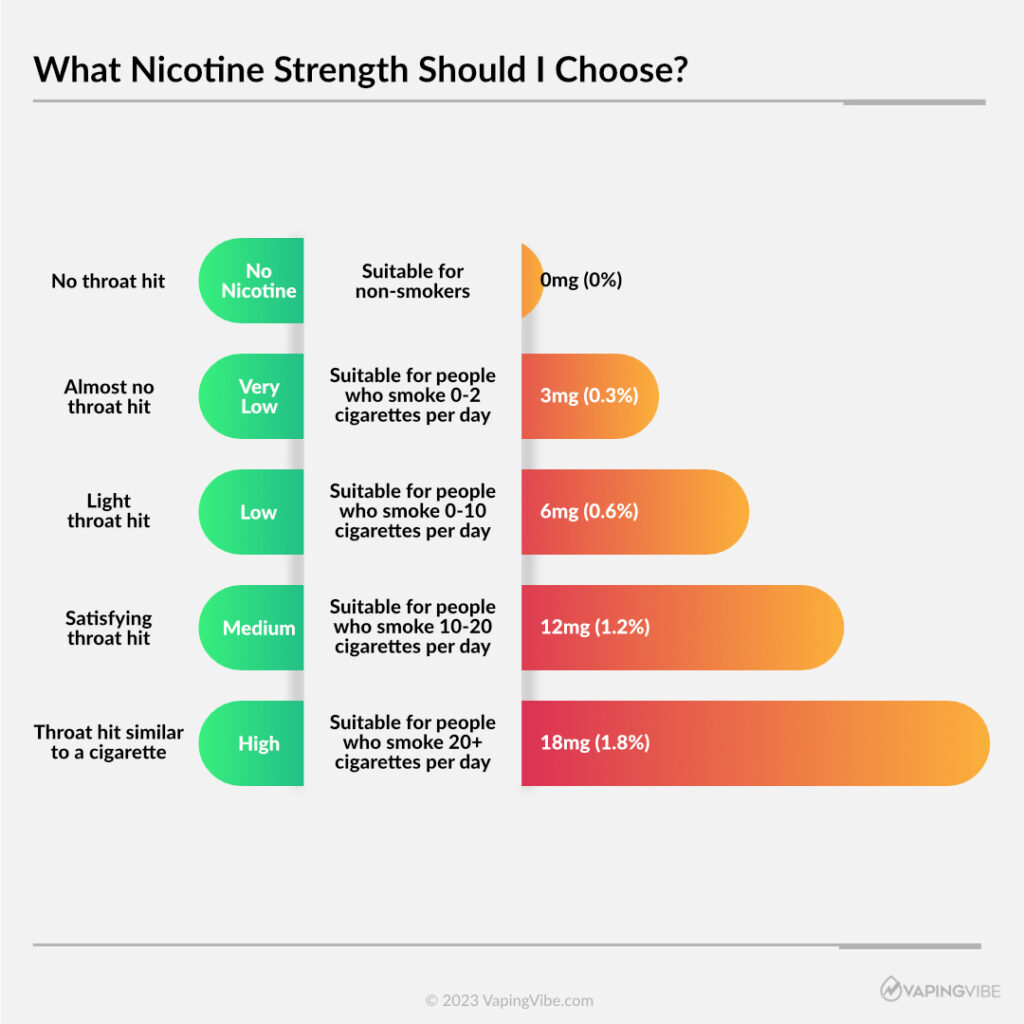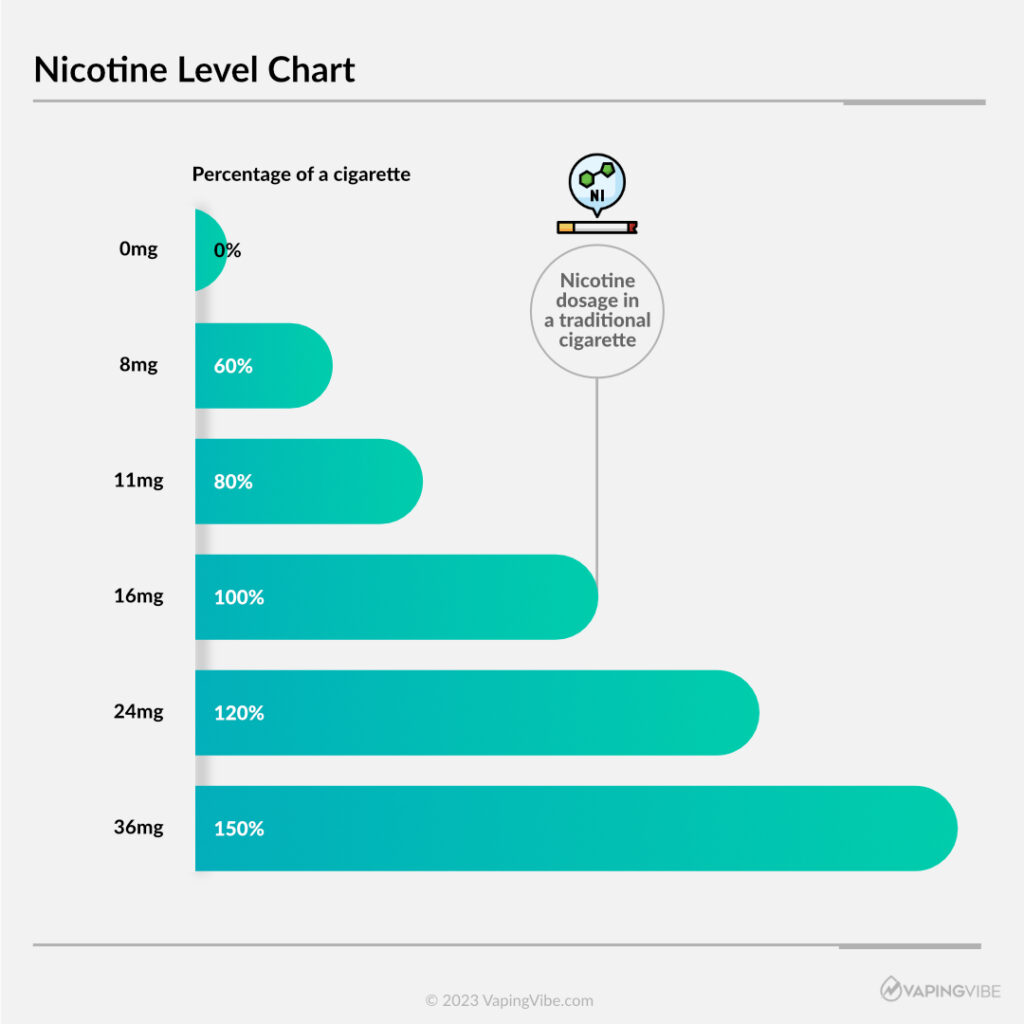QUICK LINKS
- How Many MG of Nicotine in a Cigarette?
- Finding Your Sweet Spot
- Everyone Is Different
- What Happens if I Have Too Much Nicotine?
- Nicotine Delivery From Cigarettes
- Nicotine Delivery From E-Cigarettes?
- How Much Nicotine Will I Absorb From One Cigarette?
- How Much Nicotine Will I Absorb From an E-Cigarette?
- Will I Absorb More Nicotine From Smoking Cigarettes or Vaping?
- What Nicotine Level Should I Be Vaping?
- I Want to Quit Smoking and Start Vaping; Where Should I Start?
- Start With Low-Powered Devices
- Choose a PG/VG Ratio
- Choose Your Nicotine Content
- What if I Want to Use High-Powered Devices?
- Wrapping Up
Nicotine content in cigarettes compared to vape juices.
That should be an easy question to answer if you’re a smoker, right?
I don’t think I’m alone in saying when I used to smoke I paid no attention whatsoever to the nicotine content in each cigarette. It was more a case of these are strong cigarettes, and these are lighter, but as for the actual milligrams of nicotine, I was none the wiser.
So when I transitioned to vaping, one of the first things I, and I’m sure many other ex-smokers asked themselves is, ‘Exactly how much nicotine is in my favorite brand of cigarette? And what level of nicotine should I be vaping to replicate it?’
That should be an easy thing to calculate right? Not quite.
Want to get nicotine free? Discover what we rate as the best non nicotine vapes.

How Many MG of Nicotine in a Cigarette?
Imagine my confusion when I looked at the nicotine content details on a pack of my favorite Marlboro Gold cigarettes and realized that there is 0.6mg of nicotine in a single cigarette.
E-liquid comes in strengths of 3mg, 12mg, 18mg, and even 0%! So this figure didn’t make any sense to me, and I’m an experienced vaper. I can only imagine how confused ex-smokers feel when they need to find a vape juice with a similar nicotine intake.
When you switch from smoking cigarettes to using vapes, you need to find a vape juice that has the right nicotine levels. Nicotine concentration might not seem like a big deal, but it can have a massive impact on your vape experience and your overall health. Before we compare the nicotine in tobacco products with the nicotine in nicotine salts, we need to understand what nicotine is, where it comes from, and its effects.

Finding Your Sweet Spot
If you smoke cigarettes, you might be an expert at a practice called self-titration without realizing it. You might not know just how much nicotine is in an average cigarette, but you’ll know how many cigarettes you need to smoke to get your fix.
One study found that ‘liquid consumption and puff number were higher and puff duration longer, in the low nicotine strength condition.’ Self-titration is just that, it’s when a smoker or vaper automatically alters their puff count and drag duration to receive as much nicotine as their bodies need, no matter the nicotine levels.
Irrelevant to the strength of a particular cigarette, nicotine users self-monitor and adjust their behavior and the amount they consume within a given day to fulfill their own personal level.
Given this evidence, the question moves away from ‘how many mg of nicotine in a cigarette?’ to ‘how much nicotine will satisfy my cravings throughout the day?’
For further health benefits you might even want to consider going nicotine free. Our article covers some great reasons to ditch nicotine from your vape juice entirely.
Everyone Is Different
Two people can have an identical nicotine intake but entirely different reactions.
Everyone’s body reacts to nicotine levels differently. People with a healthy immune system or larger mass may not be affected by 12mg nicotine content vape juice in the same way as a smaller person, or someone with a weak immune system.
This is why analyzing the nicotine content in cigarettes is not always the best option.

What Happens if I Have Too Much Nicotine?
Whether you smoke tobacco products or e-cigarettes, you probably know what it feels like to consume too much nicotine. We know that nicotine ‘activates structures normally present in the brain called receptors’ which release the feel-good chemical dopamine, but what happens when you consume too much of a good thing?
Regardless of the delivery method, if you inhale too much nicotine you can expect these unpleasant side effects.
- Dizziness
- Headaches
- Nausea
- Increased heart rate
- Anxiety or jitters
- Cold sweats
- Ringing ears
The phenomena of self-titration means that very few vapers take it too far. They might not know how many milligrams are in most cigarettes or vape juices, but they know how to alter their consumption with longer, shorter, fewer, or far more puffs.
People who stop smoking and switch to e-cigarettes are far more likely to experience the negative effects of nicotine. Switching between these delivery methods can be jarring, and it is no surprise that individuals who take the leap consume too much nicotine.

Nicotine Delivery From Cigarettes
Let’s look at a cigarette compared to an e-cigarette.
Cigarettes contain tobacco, which contains nicotine. The American Lung Association says that one cigarette (when burned) creates more than 7,000 chemicals. 69 of the chemicals are toxic and known to cause cancer.
In recent years, tobacco products have become even more addictive. Tobacco companies have introduced ammonia to their cigarettes, which creates a more desirable and addictive form of nicotine by changing the chemistry of the nicotine the smoker absorbs. Ammonia essentially supercharges the nicotine as it hits the brain.
It’s incredibly difficult to compare the nicotine content and delivery of a cigarette with that of e-liquid, which doesn’t contain ammonia or most of the 7,000 chemicals that are released when burning a traditional cigarette.
Smoking as a nicotine delivery mechanism is far more potent than any other delivery system. Popular nicotine replacement therapy options like patches and gums are not comparable to the average unlit cigarette. Even if a nicotine patch claims to have a higher nicotine content, it will not interact with your brain in the same way that cigarettes will.
But what about e-cigarettes?
Nicotine Delivery From E-Cigarettes?
Cigarette and e-cigarette manufacturers both use nicotine, but they source it differently. As we’ve already mentioned, cigarettes contain tobacco. Tobacco plants contain high levels of nicotine. E-cigarette companies saw the toxic chemicals in tobacco and decided to make a less toxic alternative.
Vape juice doesn’t contain any tobacco products. Instead of including the entire plant, vape brands extract the nicotine from the plant.
Whereas the average smoker inhales 7,000 chemicals, the average vaper inhales far fewer. It’s difficult to pinpoint an exact number because every manufacturer creates different batches of vape juice. One thing is for sure; your vaping device contains far fewer toxic chemicals than domestic cigarettes.
Of course, this significant change leads to far fewer chronic and fatal health conditions. Carbon monoxide and tar are just two of the toxic chemicals that are present in cigarettes, and they are widely known to be responsible for chronic obstructive pulmonary disease (COPD), diabetes, heart disease, and a number of other critical health concerns.
How Much Nicotine Will I Absorb From One Cigarette?
When we look at a cigarette compared to a vape pen, we get a lot of conflicting ideas.
Prof. Bernd Mayer of the Department of Pharmacology and Toxicology at Karl-Franzens University Graz (Austria), states that “smoking a cigarette results in uptake of approximately 2 mg of nicotine and gives rise to mean arterial plasma concentrations of about 0.03 mg/L (30 ng/ml).” In contrast, Arthur Brody argues that there’s 0.6-1.0 mg of nicotine in “light” cigarettes and 1.2-1.4mg in regular cigarettes.
However, as we know, there are a lot of determining factors in the nicotine delivery of cigarettes. This is all without mentioning other factors like depth of inhalation, and length of the cigarette.
How Much Nicotine Will I Absorb From an E-Cigarette?
In the battle between cigarettes and e-cigarettes, there is no clear winner.
One study found that ‘the maximum plasma nicotine concentration with first-generation devices ranged from 1.3 to 5.36 ng/ml five to 24 minutes after use’, but again, this is ‘depending on the nicotine concentration of the e-liquid.’
But what does this mean?
Will I Absorb More Nicotine From Smoking Cigarettes or Vaping?
It is generally accepted that you will consume far more nicotine far quicker with a cigarette compared to an e-pen. In a 2019 study, researchers concluded that people who use 3mg strength vape juice would need to vape six times as much as they would smoke to achieve the same nicotine intake as a generic tobacco cigarette.
This is just another reason why ex-smokers who switch to vaping struggle to find the right nicotine levels.

What Nicotine Level Should I Be Vaping?
As we’ve seen, there is no clear answer to this question. Nicotine content might seem like one of the simpler aspects of vaping, but think again. On top of vaping styles, customizable options, and different devices, new vapers have to work out how much nicotine they need.
This process is often bumpy and requires a lot of false starts and readjustments. There are many vaping devices on the market, and each comes with different power outputs, boost features, and customization options. Unlike smoking, the delivery method of vaping can vary depending on what style of device you are using.
Read our guide on understanding nicotine strengths for more information.
I Want to Quit Smoking and Start Vaping; Where Should I Start?
So, you’ve heard about the benefits of vaping and you want to make the switch. There’s no one size fits all solution, but here are a few tips for switching from smoking to vaping as simply as possible.
Start With Low-Powered Devices
First things first: you need to find an electronic cigarette that you like. Don’t spend too much time on this; lots of vapers soon cycle through the more basic devices and settle on their favorite in a few months.
We recommend low-powered devices to beginners. Low-powered devices are suitable for Mouth-to-Lung (MTL) vaping, which mimics the feeling of smoking a traditional cigarette. Low-powered electronic cigarettes tend to look very simple. They are known to have slim appearances and minimal features. Vape pens, starter kits, and pod mods are all good options and, even better, they are often the cheapest devices on the market.
You can get low-powered devices for $15 and up, so you don’t have to break the bank on your first vape device.
Choose a PG/VG Ratio
All e-liquids have a base that is comprised of vegetable glycerin (VG) and propylene glycol (PG). Vape juice can also contain nicotine and flavorings, but before you move on to these extras, you need to find the right base ratio.
Different e-cigarettes are compatible with different ratios. If you don’t find the right ratio for your device, you won’t be able to consume the nicotine in the product.
- High-VG e-liquids – Pair these vape liquids with high-wattage devices for the best impact. High-VG e-liquids are designed for sub-ohm devices that produce dense, immense vapor.
- High-PG e-liquids – Pair these liquids with low-powered devices and high-resistance coils. High-PG juices are designed to create intense flavors.
- 50:50 e-liquids – Believe it or not, 50:50 liquid is considered high-PG.
Choose Your Nicotine Content
This graphic is a good guide on where to start with e-liquid nicotine levels.

Typical starter kits and mouth-to-lung devices will be perfect for the levels we’ve outlined above. But remember, everyone is different. No matter what the experts recommend, you should always self-monitor and trust your instinct.
What if I Want to Use High-Powered Devices?
Lots of vapers transition to high-powered devices within a few months of making the switch. This common occurrence comes with a few essential tweaks.
In the vape world, high-powered devices tend to be sub-ohm devices. These kits are compatible with coils that are less than 1 Ohm. They are known for producing massive amounts of vapor. To achieve dense clouds, vapers need to take long, drawn-out drags on their devices. This is known as DTL (Direct-to-Lung) vaping.
When you switch from MTL to DTL devices, you need to reduce your nicotine consumption. I’ve done this myself, so I’ve got a few handy guidelines.
I started with a simple MTL device and 12mg of vape juice. Before I started vaping, I smoked Marlboro Gold cigarettes and was a relatively light smoker. 12mg was perfect for me, but it would have been terrible for a sub-ohm device. I made a lot of mistakes when I was transitioning to sub-ohm vaping, and the biggest one was using too much nicotine. My 12mg liquid made me feel dizzy and nauseous, and it even gave me headaches. Now, I use a 3mg liquid.
Getting dizzy after vaping? Learn about the nicotine buzz and how long dizziness lasts after vaping.
Wrapping Up
So, how much nicotine is in a cigarette?
If you smoke Marlboro Gold cigarettes, that number might be 0.6mg. The amount varies widely between cigarettes but, as we’ve discovered, it’s not necessarily the most important number, especially for people who want to transition to vaping.
No matter how confusing the world of vaping is, remember, you are in charge of your consumption. Self-titration is your best friend. Have faith in yourself, follow the guidelines, and find the perfect nicotine content for you.

